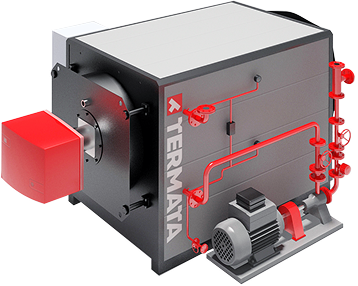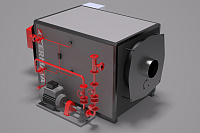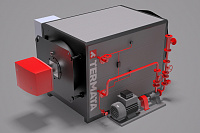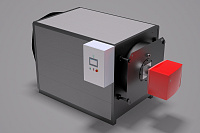Submit a Request and Get a Free Consultation
Submit a request, and we will contact you to provide consultation on any questions
Thermal oil boilers
TERMATA KX Thermal Oil Boilers
Designed for heating and automatically maintaining temperature during bitumen preparation at asphalt plants. Diathermic oil heats up to 300-360 °C, has high heat capacity, allows precise temperature control, and prevents scale formation on the boiler's internal surfaces, reducing maintenance costs. This heat transfer medium lowers the risk of pipe corrosion compared to water, as it coats the interior and protects against oxygen exposure. Such systems are characterized by high durability.
Modification year — 2016
- Таблица 1
Characteristics Useful Power Furnace Power Efficiency at 100% (P.C.I.) Max Gas Consumption G20 Max Gas Consumption G30 Max Gas Consumption G31 Max Flue Gas Consumption Flue Gas Pressure Loss Heat Loss Through Chimney Heat Loss Through Casing Liquid Pressure Loss Design Pressure Max Operating Temperature Total Oil Volume Total Weight Flue Gas Temperature Model kW kcal/h kW kcal/h % m³/h kg/h kg/h kg/h mbar % % mbar bar °C L kg °C °C Average Temperature 70°C Average Temperature 260°C Gas Diesel KX 400 465 400 541 465 86.35 57.22 42.47 42.01 852.58 2 12.85 1.2 1000 10 290 206 1500 321 322 KX 600 698 600 810 697 86.08 85.76 63.65 62.96 1277.82 3.5 12.63 1.2 1600 10 290 206 1750 316 317 KX 1000 1163 1000 1351 1162 86.07 10.37 142.98 106.12 104.97 3.5 12.72 1.2 1680 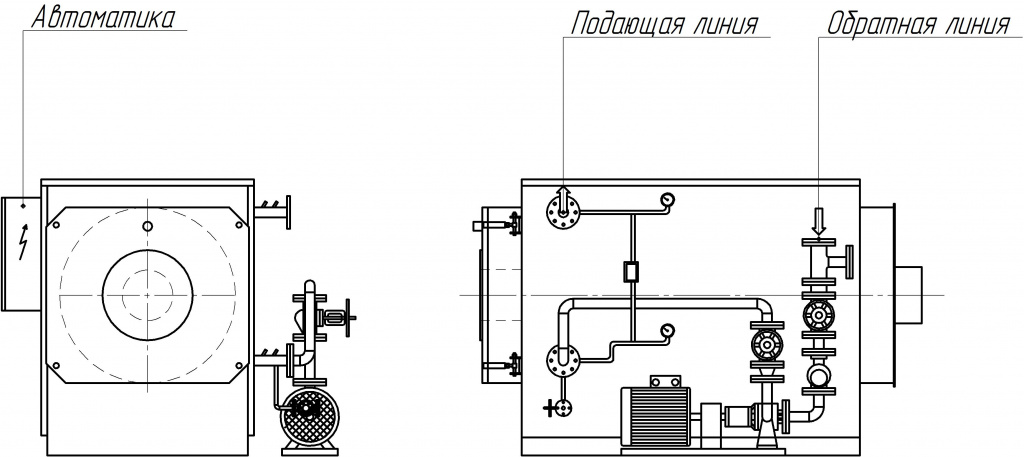
- Таблица 2
Dimensions H H1 L L1 L2 Øb Øc N1 N2 N3 N4 mm mm mm mm mm mm mm DN/in DN/in DN/in DN/in KX 400 1450 825 1790 1280 1565 280 300 50 50 40 20 KX 600 1495 835 1885 1340 1625 280 350 65 65 40 20 KX 1000 1605 890 1985 1400 1735 280 400 80 80 50 20 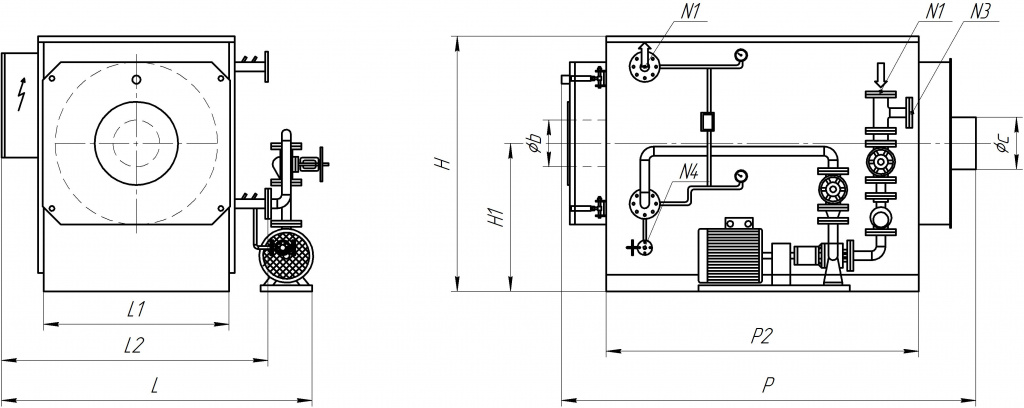
- Таблица 3
- The distinctive feature of oil-fired boilers is the use of oil as a heat transfer medium. Unlike water, thermal oil heats up linearly and can reach a temperature of 350 °C at a pressure of 10 bar (for comparison, steam at the same temperature requires 180 bar). Diathermic oil ensures uniform heat distribution in technological processes, such as bitumen heating.
Depending on operating temperatures, mineral or synthetic oils are used. Synthetic oils are applied in circuits with temperatures up to 400 °C. The circulation of the heat transfer medium is forced using pumps. The oil in TERMATA boilers does not require purification and lasts 6-7 years.
The thermal oil system with mineral oil is an open system equipped with a degasser to remove oxygen and water vapor, preventing pipe corrosion. As the oil heats up, it expands, so the system includes an expansion tank and a drain tank for the heat transfer medium in case of repairs or maintenance.
The large-volume combustion chamber has a low thermal load and is protected by tangential tubes. The oil circulation speed is regulated between the combustion chamber and the convection plate to optimize system pressure.
The boiler's outer casing is made of sheet metal with stiffening ribs. Double mineral wool panels provide thermal insulation, and the outer shell is protected by corrugated steel sheets.

Advantages of TERMATA KX Boilers
- Diathermic oil has high density, affecting the heating speed and heat retention.
- The operating temperature reaches 300–360 °C, allowing the boilers to be used in technological processes with high temperature requirements.
- The oil reduces the likelihood of scale formation inside the boiler, which may decrease the need for cleaning.
- Boilers with this heat transfer medium are used in systems requiring a stable temperature regime.
- Temperature parameters contribute to efficient heat distribution.
- Operation at low pressure in pipelines reduces the load on equipment.
- The automated control system does not require constant personnel supervision.
- The heat transfer medium has anti-corrosion properties, impacting the equipment’s service life.
Applications of TERMATA KX Boilers
TERMATA boilers with diathermic oil are actively used in asphalt production, the food industry, petrochemicals, the manufacturing of construction materials, furniture, and roofing—in other words, in areas requiring boilers with a heat transfer medium that heats up to very high temperatures. However, thermal oil boilers are also suitable for domestic use: they are widely utilized by homeowners' associations, new cottage districts, and private sectors. They are also used to conduct chemical reactions, perform hot pressing, and increase the temperature in drying systems.
Design and Operating Principle:
TERMATA thermal oil boilers are horizontally designed with spiral coils. The coils are made of seamless tubes bent into parallel spirals to ensure the separation of different exhaust gas paths.
The first inner spiral coil forms a large-volume combustion chamber to provide high operational flexibility under various consumer-required loads.
The second coil forms an outer convective bundle for the removal of the second exhaust gas path. The third gas path occurs in the outer cylindrical casing.
The base is made of steel profile (carbon steel), ensuring structural strength and ease of movement, with a working platform and connection for the diathermic oil circulation group provided on the side.
The front door is attached with bolts, easily opens for inspection and cleaning, and is equipped with a burner installation cone and a flame observation window.
Fuel combustion occurs using a block burner. The flame enters the inner cylinder, transfers part of the heat, then reverses and passes along the inner and outer cylinders before reversing again. In the final pass, the flue gases transfer the remaining heat to the outer cylinder and exit through the chimney. Thanks to the extended flame path, the system’s efficiency is at least 92%.
Characteristics Useful Power Furnace Power Efficiency at 100% (P.C.I.) Max Gas Consumption G20 Max Gas Consumption G30 Max Gas Consumption G31 Max Flue Gas Consumption Flue Gas Pressure Loss Heat Loss Through Chimney Heat Loss Through Casing Liquid Pressure Loss Design Pressure Max Operating Temperature Total Oil Volume Total Weight Flue Gas Temperature Model kW kcal/h kW kcal/h % m³/h kg/h kg/h kg/h mbar % % mbar bar °C L kg °C °C Average Temperature 70°C Average Temperature 260°C Gas Diesel KX 400 465 400 541 465 86.35 57.22 42.47 42.01 852.58 2 12.85 1.2 1000 10 290 206 1500 321 322 KX 600 698 600 810 697 86.08 85.76 63.65 62.96 1277.82 3.5 12.63 1.2 1600 10 290 206 1750 316 317 KX 1000 1163 1000 1351 1162 86.07 10.37 142.98 106.12 104.97 3.5 12.72 1.2 1680 
Dimensions H H1 L L1 L2 Øb Øc N1 N2 N3 N4 mm mm mm mm mm mm mm DN/in DN/in DN/in DN/in KX 400 1450 825 1790 1280 1565 280 300 50 50 40 20 KX 600 1495 835 1885 1340 1625 280 350 65 65 40 20 KX 1000 1605 890 1985 1400 1735 280 400 80 80 50 20 
- The distinctive feature of oil-fired boilers is the use of oil as a heat transfer medium. Unlike water, thermal oil heats up linearly and can reach a temperature of 350 °C at a pressure of 10 bar (for comparison, steam at the same temperature requires 180 bar). Diathermic oil ensures uniform heat distribution in technological processes, such as bitumen heating.
Depending on operating temperatures, mineral or synthetic oils are used. Synthetic oils are applied in circuits with temperatures up to 400 °C. The circulation of the heat transfer medium is forced using pumps. The oil in TERMATA boilers does not require purification and lasts 6-7 years.
The thermal oil system with mineral oil is an open system equipped with a degasser to remove oxygen and water vapor, preventing pipe corrosion. As the oil heats up, it expands, so the system includes an expansion tank and a drain tank for the heat transfer medium in case of repairs or maintenance.
The large-volume combustion chamber has a low thermal load and is protected by tangential tubes. The oil circulation speed is regulated between the combustion chamber and the convection plate to optimize system pressure.
The boiler's outer casing is made of sheet metal with stiffening ribs. Double mineral wool panels provide thermal insulation, and the outer shell is protected by corrugated steel sheets.

Advantages of TERMATA KX Boilers
- Diathermic oil has high density, affecting the heating speed and heat retention.
- The operating temperature reaches 300–360 °C, allowing the boilers to be used in technological processes with high temperature requirements.
- The oil reduces the likelihood of scale formation inside the boiler, which may decrease the need for cleaning.
- Boilers with this heat transfer medium are used in systems requiring a stable temperature regime.
- Temperature parameters contribute to efficient heat distribution.
- Operation at low pressure in pipelines reduces the load on equipment.
- The automated control system does not require constant personnel supervision.
- The heat transfer medium has anti-corrosion properties, impacting the equipment’s service life.
Applications of TERMATA KX Boilers
TERMATA boilers with diathermic oil are actively used in asphalt production, the food industry, petrochemicals, the manufacturing of construction materials, furniture, and roofing—in other words, in areas requiring boilers with a heat transfer medium that heats up to very high temperatures. However, thermal oil boilers are also suitable for domestic use: they are widely utilized by homeowners' associations, new cottage districts, and private sectors. They are also used to conduct chemical reactions, perform hot pressing, and increase the temperature in drying systems.
Design and Operating Principle:
TERMATA thermal oil boilers are horizontally designed with spiral coils. The coils are made of seamless tubes bent into parallel spirals to ensure the separation of different exhaust gas paths.
The first inner spiral coil forms a large-volume combustion chamber to provide high operational flexibility under various consumer-required loads.
The second coil forms an outer convective bundle for the removal of the second exhaust gas path. The third gas path occurs in the outer cylindrical casing.
The base is made of steel profile (carbon steel), ensuring structural strength and ease of movement, with a working platform and connection for the diathermic oil circulation group provided on the side.
The front door is attached with bolts, easily opens for inspection and cleaning, and is equipped with a burner installation cone and a flame observation window.
Fuel combustion occurs using a block burner. The flame enters the inner cylinder, transfers part of the heat, then reverses and passes along the inner and outer cylinders before reversing again. In the final pass, the flue gases transfer the remaining heat to the outer cylinder and exit through the chimney. Thanks to the extended flame path, the system’s efficiency is at least 92%.
